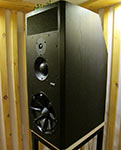| Author
|
Problem with the mix - muddy bass on a big soundsystem
|
hnd

Started Topics :
6
Posts :
34
Posted : Dec 15, 2013 13:35:52
|
Hi guys,
After finishing my track I've checked the mix on various headphones & speakers (car audio, hi-fi, computer speakers) and thought it sounds okay. Yesterday when I've played it on a club soundsystem suddenly the bass overpowered other sounds and the mix became totally muddy.
What's strange: I've compared the spectrum analysis with some full-on tracks, and apparently I've got significantly less low end than professional artists - you can see both analyses below:
My track's spectrum: 
Spectrum I compared to (Ephedrix - Astral Ignition): 
How can you explain it? I'm a total beginner so please go easy on me  |

|
|
knocz
Moderator

Started Topics :
40
Posts :
1151
Posted : Dec 15, 2013 14:05
|
Hi!
Well, muddyness is a bit vague, but nevertheless a very used term in the mixing world, unfortunately. And it's up to you, the mixing engineer, to clear this up without making your mix too thin.
There's no way any of us can tell exactly where the problem resides with just one screenshot of Voxengo SPAN: it's like I'll send a picture of my car's speedometer going 1000 Km/H to my mechanic and ask him why the car is making a weird noise.. he just couldn't answer me 
A mix is something to be tamed, and a good mix is not trivial to achieve.
However, I'll try to give you some more info as I can: the bass is not only in your sub-bass section, you can see in your second screenshot the big dip around 200Hz. This is not a standard, it's that particular track that needed that dip, and it must of worked. In your case, you must detect the "type of muddiness" and EQ it accordingly -> and the closest to the source is the best, so slapping an EQ on the master bus might not do it.
I would recommend you, as a pointer not a guide, to read the book "the art of mixing", or something similar. There, Gibson details a lot of types of muddyness and other mixing slang and advises how to take care of it.
Furthermore, on the second screenshot you see, apart of some shallow peaks around 12kHz, the main energy is from 60 Hz to maybe 140 Hz, making this the most prominent part of the tune, as with your tune in the first screenshot this doesn't happen.
Also, it's not just about numbers, as the kick and bass tone has a lot to do with how the mix sounds, so you must try to correct the issues there instead of at the final stage in the master bus.
Hopefully you've read what I just wrote, and you've searched for terms you don't know about and investigated a bit, so here's the shortcut: due to many reasons too long to enumerate, our body takes 500Hz as being muddy or as being thin. In your tune at 500Hz you have a huge peak, and in the reference track there actually is a little dip. So, instant fix take an EQ and cut out some of those frequencies, but be careful not to take too much out or it would be too thin (this is a tip from the art of mixing, there are many more int the book for you to absorb  ) )
Also, the main difference between your studio and a PA is volume (or gain)! So try playing your tune at full blast in your studio to understand how it might translate on a fukk PA system (just as a reference, please don't produce at high volumes or you won't be producing for long). With experience you'll be able to understand more on how it translates and get it right at the start.
If you speak with a mastering engineer with your tunes, it would help a lot, as your would e paying someone with years of experience giving the final touches to tunes that have blasted us away in PA's and would most certainly get a lot of feedback even before he does anything to your tune.        Super Banana Sauce http://www.soundcloud.com/knocz Super Banana Sauce http://www.soundcloud.com/knocz |

|
|
hnd

Started Topics :
6
Posts :
34
Posted : Dec 15, 2013 14:35
|
Thank you for such a quick and comprehensive answer! I know I've got a lot to learn and I will definitely try to get my hands on the book you mentioned.
Thank you so much for the advice! Cheers |

|
|
frisbeehead
IsraTrance Junior Member
Started Topics :
10
Posts :
1352
Posted : Dec 15, 2013 15:14
|
Looking at the "speedometer", your low end instruments are not the loudest in the mix. And they should!
Usually, the kick will be the loudest sound on a track, followed closely by the bass. Problem with your track, just by looking at this is that there's something going on the 200Hz region that's higher then what's bellow, when typically you'd have those two fundamental tones near 60hz and 100-130hz more prominent - 'cause they correspond to the fundamental tones on the low end instruments.
That dip mentioned above is important. This is no rule (!!!) but there's usually some mud to tame on the 200-270Hz region, on the Bass sound (again, no gospel, just some numbers that are common). Plus, it helps to shape the overall tone of the track if you create more separation between the sounds, not razor sharp separation, but just finding the space for instruments or groups of instruments.
So, if I were you I'd group the separate channels into groups like: low end, drums, leads+pads, cymbals and top end stuff. Then it's much easier to find the relative values between these groups of sounds, and make some broad stroke adjustments as you go. I can tell by looking at the graph that your low mids have completely washed out the perception of the low end. You know, there's only room for one loudest part, only so much headroom available. All about balance! Keep it up!
EDIT
for some reason, voxengo's span (on the default setting) displays the higher frequencies higher in volume then they really are. So watch out for that |

|
|
frisbeehead
IsraTrance Junior Member
Started Topics :
10
Posts :
1352
Posted : Dec 16, 2013 06:26
|

this is just with kick+bass and drums playing on a project here. it kind of illustrates what I've said previously: you can see where the leads go just by looking at it  |

|
|
supergroover
IsraTrance Junior Member

Started Topics :
39
Posts :
1505
Posted : Dec 16, 2013 08:26
|
Can you post the track on soundcloud and post it in the workshop section for some feedback?
        soundcloud.com/supergroover soundcloud.com/supergroover |

|
|
Babaluma
IsraTrance Junior Member

Started Topics :
18
Posts :
729
Posted : Dec 16, 2013 12:15
|
We should be deciding things on how it sounds, not how it looks, but from the diagrams only, it's easy to see your track has way more lower mid range energy, which I usually find to be the "mud" frequencies (anywhere from around 200-500Hz). Try scooping some of that out in the individual tracks (not on the master buss), to make a bit more space down there. It's a range I'm often having to pull down slightly in mastering, with inexperienced engineers in bad acoustic spaces with poor monitoring.
This frequency range is where the bass and kick often have their 2nd/3rd/4th harmonics, and where many mid range instruments have their fundamental frequencies, so it's easy to get "busy" in this region.
        http://hermetechmastering.com : http://www.discogs.com/artist/Gregg+Janman : http://soundcloud.com/babaluma http://hermetechmastering.com : http://www.discogs.com/artist/Gregg+Janman : http://soundcloud.com/babaluma |

|
|
xoC
Cubic Spline

Started Topics :
10
Posts :
179
Posted : Dec 16, 2013 12:49
|
Quote:
|
On 2013-12-16 12:15, Babaluma wrote:
We should be deciding things on how it sounds, not how it looks, but from the diagrams only, it's easy to see your track has way more lower mid range energy, which I usually find to be the "mud" frequencies (anywhere from around 200-500Hz). Try scooping some of that out in the individual tracks (not on the master buss), to make a bit more space down there. It's a range I'm often having to pull down slightly in mastering, with inexperienced engineers in bad acoustic spaces with poor monitoring.
This frequency range is where the bass and kick often have their 2nd/3rd/4th harmonics, and where many mid range instruments have their fundamental frequencies, so it's easy to get "busy" in this region.
|
|
+1
Quote:
|
On 2013-12-15 14:05, knocz wrote:
[...]
Also, the main difference between your studio and a PA is volume (or gain)! So try playing your tune at full blast in your studio to understand how it might translate on a fukk PA system (just as a reference, please don't produce at high volumes or you won't be producing for long). With experience you'll be able to understand more on how it translates and get it right at the start.
[...]
|
|
No. I have never seen a big PA soundsystem tuned to FLAT and sound good for electronic music : at that levels, the mids and high can get too much aggressive. So usually, the subs have a lot more gain that the rest of the speakers, in some places, something like 15 dB of gain can be needed to sound good and deep.
That makes the low mids just above a difficult range. Sometimes the subs gain give them some boost and muddiness is easy, sometimes not and they are masked, it depends how did the sound engineer tuned the system.
        http://www.storm-mastering.com http://www.storm-mastering.com |

|
|
frisbeehead
IsraTrance Junior Member
Started Topics :
10
Posts :
1352
Posted : Dec 16, 2013 16:29
|
It's easier when you listen, yes. But on this particular case, you can actually tell a lot just by looking at it. Not like we haven't looked at it like a milion times before. There's to much low mids going on for sure, and I'm willing to bet that there isn't enough separation between the different elements in the track and a proper gain structure.
So... I also subscribe what's said above, just post it on the workshop section and you'll get a free workhorse of trained ears dissecting your mix (did I mention free?) |

|
|
hnd

Started Topics :
6
Posts :
34
Posted : Dec 16, 2013 23:00
|
Again, thank you for all the answers. I will try to do my best and fix what I can using advice posted here and then of course I will post results in the Workshop section.
Man, you just gotta love this forum  |

|
|
|